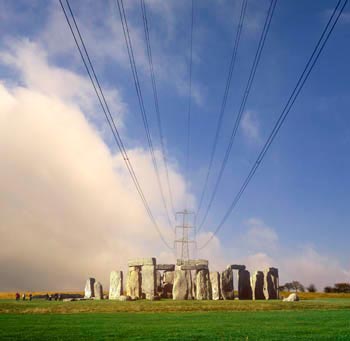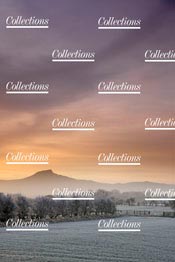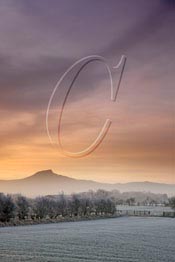Useful terms
This guide was last updated in 2013 and some of the rules of copyright may have been revised and added to in the intervening years, particularly in regards to digital use.
Photographically, this means an old-fashioned transparency or negative film which requires processing - a technique which is rapidly disappearing. Analogue film when increasingly enlarged eventually becomes a mush of colour with no form to it. It has a continuous varying tone. An original transparency or negative is first generation; it’s the same piece of film which was in the camera. A print from an original is second generation as is a duplicate transparency from an original. A print from a duplicate is third generation and can be dreadful. Every step away from the original is retrograde although black and white prints which are second generation are not because they are creative, artistic and necessary as are some colour prints.
A contraction of the word Web Log. The term first appeared around 1997 as both a noun – a blog – and as a verb – to blog. One who blogs is a blogger. It’s not a pretty word but is now firmly entrenched. A blog is accessible to anyone who knows where to look, is maintained by individuals or companies and entries may include comments on practically anything including the esoteric and occasionally the deeply unsavoury. Some express the beliefs of those who want to get something out of their system at the same time as involving others; some are seriously defamatory; some are very funny; some are read avidly and some probably not read at all; many are appallingly badly written whilst others are highly professional. The best are rivetingly interesting.
see Internet
This is a mobile phone which takes photographs and these days, that is practically every mobile phone. Early versions were not good but quality has improved so fast that some are now better than dedicated digital cameras. Copyright in anything taken on a mobile phone belongs to whoever takes the picture. It is simply a digital image and reproduction fees should be paid when these images are reproduced. It may be a good thing to arrange a fee first. If an image is something spectacular it could be worth while shopping around for a better offer. Once published, the image still belongs to the photographer and if it is very newsworthy, considerable care should be taken to police its use because such images escape. The BBC and other media sources are forever asking viewers to supply images and suggesting this should be done with a mobile phone. Make sure you understand the ramifications before supplying. Copyright belongs to the photographer and not to the BBC or anyone else, but you must make sure, if you are uploading via a sharing app, that you carefully study the terms and conditions of the site; many have clauses that permit them to exploit your work in any way they see fit. This could mean your party pictures being used in their advertising or your pictures at the scene of a disaster being sold very profitably and you not seeing a penny! Newspapers rely on such pictures when disasters happen.
A digital file, whether high or low resolution, uses a lot of available disk space. Because of this, files are usually compressed. The industry standard is JPEG. Compression removes some pixels throughout the entire image. Where there are identical pixels next to one another, compression removes one of them. When the file is decompressed, something similar is put back in although there is no guarantee it’ll be the same. There are degrees of compression; minimum compression removes very few pixels and when the file is decompressed it’s unlikely to show. Maximum compression may produce a final decompressed version which does not look too good.
Strictly speaking, it shouldn’t be necessary to go into lengthy explanations about rights concerning digital images because they too are protected by copyright and are theoretically no different from analogue but there are so many conflicting versions of what it all means that it is probably just as well to supply some basic digital information for those who may never have thought about the technicalities.
‘Digital’ is information using long sequences of the numbers 0 and 1, which is the language a computer understands. In the case of photographs a computer is able to turn all the numbers into prints or colour separations for printing as well as images viewable on a screen. All this data can be sent anywhere electronically or transferred onto a disk The science behind this is extraordinary and beyond anyone who cannot cope with a world which contains only 0 and 1 or who lost touch with mathematics when it became algebra and never learned to multiply beyond twelve.
Where digital cameras are concerned, the very best and most expensive are good. The cheaper end of the market are not good and do not provide images suitable for publication but are great fun. There are many photographers who believe analogue will always be best but film and processing are becoming harder to find and will become increasingly expensive.
Analogue images can be scanned and turned into digital images, cleaned, corrected and manicured. These days, every analogue image published must be scanned in order to prepare it for print. On the whole, photographers who supply analogue images accept that scanning is a necessity but would be seriously outraged if a client automatically scanned for their own convenience and possible profit everything sent in an analogue submission. They would also be outraged if the client retained all the high resolution digital images supplied because the chances are that identification and caption, usually referred to as Metadata, would fail to remain with the scanned photographs, leaving the client with a nice little selection of unidentified photographs to use as he wished, all of them copyright infringements.
Once scanned, any number of identical copies can be made available and every one is as good as the first. They can be sent anywhere in the world electronically in a matter of minutes, there are no more transparencies lost in the post and the days of terrible duplicate transparencies are thankfully gone. Digital images have no integrity. They are manipulated to remove rubbish, blemishes, phone wires, yellow lines, scaffolding, advertising, pimples, fat, wrinkles, people, disgraced politicians - anything which shouldn’t be there or which could cause embarrassment or a problem. Analogue transparencies have always been manipulated but in a different way. Photographers would attempt to avoid blemishes and would move the rubbish first and it was always possible to re-touch afterwards although it was never as good as using Photoshop and doing it digitally.
As for copyright, digital and analogue are no different. A digital photograph has the same protection as an analogue photograph. The only difference is with ‘computer generated works’. This is defined as ‘generated by computer in circumstances such that there is no human author of the work’ and this doesn’t easily accommodate photographs. However, a computer generated image may contain elements of many other images and each of these will be a copyright infringement if the owner of the original has not given permission for the image to be included. It’s exactly the same as a collage. The final image may contain the copyright of dozens of photographers - as well as the creator of the complete image.
This is the scientific bit. A digital image is different from an analogue image in that instead of being a continuous varying tone stored on a bit of film, the image is made up from thousands of tiny squares called pixels, stored on a computer chip. Technically, a pixel is the smallest plottable point on a computer screen or imaging system and consists of 24 bits - 8 bits per colour used on a computer monitor which is RGB (red/green/blue). An image created using a digital camera can be stored on computer and supplied to a client at whatever resolution the camera is capable of creating. An analogue transparency can be scanned at high or low resolution and stored in the same way. High resolution has many more pixels to the inch than low resolution because the pixels are a lot smaller. When an image is increased in size on screen, gradually all the pixels begin to show. With low resolution this happens quite quickly. With high resolution it takes a lot of enlarging before the pixels are obvious. If an image is reproduced with a resolution which is too low, the pixels may show or the image will appear out of focus. If it’s just a case of sending a client an idea of what is available, low resolution is fine. If the client likes what he sees, the transparency can be scanned at high resolution which will be suitable for reproduction. How high the resolution should be is worked out with a complicated bit of binary mathematics which determines what resolution should be used for the size required on the page. In practice, a client often has no idea at what size the image will appear and may be a bit vague in which case assume about A4 because it’s usually sufficient and the client can always ask for something larger if necessary.
There is a mathematical rule of thumb for determining the size of a digital file. The size required in inches multiplied by dpi x 2. (dpi is dots per inch)This produces a total in pixels. What determines dpi is the intended quality and size of reproduction. The higher the figure, the better the final result.
For a reproduction at 12"x10" for printing in a publication which uses 175 dpi as standard:
- 175 x 2 = 350
- 10" x 350 = 3500
- 12" x 350 = 4240
- 3500 x 4200 = 14,700,000 pixels
At 24 bits or 3 bytes per pixel (for an RGB image), this equals 44,100,000 bytes. To turn this into Mb, 44,100,000 is divided by 1024 twice. (1024 is 2x2x2x2x2x2x2x2x2x2 which is 2 to the power of 10.)
Thus, the final figure is a requirement for a 42.06 Mb file. For newsprint, the file size doesn’t need to be so big but for anything requiring fine reproduction, this file size might not be big enough.
- binary a counting system based on the powers of 2. Two states are possible. ON = 1 and OFF = 2. Computers use the binary system because it’s easier to get electrical circuits to retain ON and OFF states than anything in-between
- bit the smallest unit of computer information, based on the binary system
- byte a unit of computer memory composed of 8 bits. A byte multiplies upward
- Kb Kilobyte = 1024 bytes (210)
- Mb Megabyte = 1024 Kb
- Gb Gigabyte = 1024 Mb
- dpi dots per inch
- pixel The smallest plottable point on a computer screen or imaging system.
Making a copy of a work, occasionally in order to preserve it for posterity but usually for convenience. This means storing it digitally and periodically transferring it as newer systems supersede older equipment. It is all too easy for equipment to become out of date, rendering what has been stored unreadable. Applied to music and film, format shifting means copying from a CD to an MP3 and then eventually onto whatever comes next or putting a television program onto a DVD or video. Photographically it means scanning an original negative, transparency or print onto disk or into a computer which enables the image to go on-line. It is a requirement that copying should only be done if the person copying owns rights in whatever is being copied or has permission. With music, it is necessary to own a copy of the CD, record or tape before copying it. In practice, file sharing is universal, few purchase the original disk or would seek permission even if they knew who to ask and on the whole, would continue to format shift even if they knew it was against the law.
Joint Photographic Experts Group, the industry standard for compression. Christina Michalos in her admirable book ‘The Law of Photography and Digital Images’ sums up jpegs pretty well ‘a jpeg image is compressed in order to keep the image size smaller and make it faster to load and easier to store.’ There couldn’t be a better way of putting it. JPEG works by averaging a block of pixels so is not a lossless method, some of the picture data is discarded, the heavier the compression the greater the detail lost. Over compression will eventually become visible
This is a box with a translucent top, filled with very white neon tubes - the whiter the better. A lightbox is absolutely essential for looking at transparencies and black and white negatives. These digital days, office lightboxes have become the dumping ground for coffee cups and general rubbish. The white light is great and is wonderful for anyone suffering from S.A.D - Seasonal Affective Disorder or winter depression. A lightbox requires a LUPE - see below
Lightbox has become the name given to a selection of low resolution digital images, preferably watermarked, sent to a client prior to supplying high resolution images. A lightbox is usually supplied at about 72 dpi so unsuitable for reproduction although this does not usually deter the unscrupulous.
This is what you must have in order to look at transparencies on a lightbox. It’s a magnifying glass which is made especially for the job. Some people prefer a linen tester which is the same thing but it folds up small. Lupes come in different sizes according to whether you want to look at 120 film or 35mm and also in varying magnifications. The most popular is X4 but they come in all sorts. A X20 which is usually very tiny, is great for reading details in transparencies which may give clues as to when and where a picture was taken. Never buy a cheap lupe or settle for a freebie; plastic lupes are hopeless. lupes need to be expensive. Never lend one to anyone and if working in an open office, use the ghastly bit of string supplied with it and hang it round your neck. Lupes. like lightboxes, are things of the past but they are useful for checking on digital prints and producing one in order to examine a print can occasionally cause consternation.
This used to be called retouching but now that it’s done digitally, it’s manipulation, accomplished with the delights of Photoshop. It means cropping, straightening skylines, correcting perspective, cleaning, inserting pretty clouds in clear sky, reducing a size16 model to a size 0 - or vice versa - whilst also removing her acne, getting rid of intrusive sponsorship and advertising signs, adding a few daffodils to make it look like spring or colouring green leaves brown to look like autumn, altering the overall colour of a photograph to remove the dreadful filters photographers seem to feel are necessary, salvaging photographs which have faded or turned magenta with age and restoring old prints. However, see Moral Rights

Collections/Roger Scruton and David M Hughes

Collections/John Miller
Manipulations by Simon Shuel
Black is white and white is black and the negative must be printed to make it right. Colour negatives look bizarre; yellow is blue, cyan is orange and green is magenta. Prior to digital cameras photographers tended to use transparency film which is processed with all the colours the right way round and is called Positive. Working with colour negative is convenient in places where the ambient colour is unpredictable because everything can be corrected when making a photographic print, not possible with colour transparencies which need to be colour corrected with filters before an analogue photograph is taken. Digitally, practically everything can be corrected later if the colours are wrong and many digital cameras have an uncanny knack of correcting colour casts without being told to do so.
A great toy. Without Photoshop, pimples, cellulite, love handles, bulges, rubbish, embarrassments, disgraced politicians, TV aerials, vapour trails and all sorts of blots and blemishes would still be removed painstakingly by a man with a pot of process white, a few colours and a brush. The classic demonstration of what can be done with Photoshop is straightening the Leaning Tower of Pisa. It can be a very useful tool but it can also be the means to sterilize and manicure a perfectly good photograph, Photoshop can tell a lot of appalling lies and sometimes it all goes hideously wrong! photoshopdisasters.blogspot.com
Adobe, who supply the programme, do not take kindly to the use of ‘to photoshop’ as a verb. However, 90% of photoshopping is done using Photoshop! Other image manipulation programmes are available, but none are as good.
Adobe recently announced they were no longer going to issue their Creative Suite products as discs or downloadable software, instead they are moving to a subscription only “Cloud” based model which has caused much annoyance among users. They intend to store your pictures and do all the manipulation on their servers for which they will charge you a monthly subscription (£17.58 for a single application at present if you sign up for a year). It remains to be seen if this will work, but I suspect there will be a lot of users sticking with their old versions!
Raw image files are minimally processed data from digital cameras or scanners. They are what comes first before anyone has done anything with them. Every camera manufacturer has different raw formats and all their results vary.
This is physics. RGB is Red, Green, Blue and are the primary colours of transmitted light. CMYK is Cyan, Magenta, Yellow (the primary colours for pigments) and the K is Black (or Key). Red and green light make yellow, green and blue light make cyan, blue and red light make magenta. On the flip side, cyan and yellow inks make green, yellow and magenta inks make red, magenta and cyan inks make blue.
Unless a computer screen is black and white, it will only produce RGB, red, green and blue. The printer sitting beside your desk will generally require CMY, cyan, magenta and yellow as will the printers used to print daily papers, books and magazines. When the three primary colours for transmitted light are added together, they should make a perfect white. All the white on a computer screen is really 100% red, green and blue. In a perfect world, when the three primary colours for reflected light (pigments on paper) are printed together they should make a perfect black but this is not a perfect world which is why K - black - is added.
A slide is a transparency, usually 35mm. Professionals tend to refer to transparencies. Amateur Holiday Snaps used to be referred to as ‘slides’ but are vanishing with the digital revolution. It’s a lot easier to load a CD onto a laptop in order to see the kids shivering on the beach at Brighton than it is to load a projector, draw the curtains, unroll the screen, discover the slides are upside down and back to front and that the projector bulb has blown. Projectors these days are seriously old fashioned.
Tagged Image Format File. An original tiff is not compressed and is better for image integrity and quality than a compressed jpeg, but the files are very big, use up a lot of space and take time to send. Unless tiffs are vital, jpegs are used instead which compress images a lot in order to make them easier to manage. TIFF is a standard format and all imaging and publishing programmes on any platform should be able to read them.
In the days when everything was analogue, picture submissions were supplied as photographic prints or as transparencies on 35mm, 6x4.5, 6x6, 6x7, 6x8, 6x9, as well as all sorts of long, thin panoramic pictures which look wonderful but never seem to make it onto the page because designers tend to lay out magazines to a grid which doesn’t accommodate odd shapes. 35mm are small, otherwise known as slides and the film runs to 36 frames. Above that, most film is called 120 which does not refer to size but to a stock number devised by Kodak in 1902. It is in fact 6cm wide and 6x4.5, 6x6, 6x7, 6x8, 6x9, and everything beyond are all produced on the same film. The size of the frame is determined by the camera but the width is always the same. There is also 5x4 sheet film which is shot sheet by sheet and for some reason is measured in inches rather then centimetres. There are even larger sizes but they are not for your everyday photographer. The bigger the film, the bigger and heavier the camera. On the whole, photographers are not inclined to take 5x4 cameras up Mount Everest.
Low resolution photographs sent on CD or by e-mail should always have a watermark embedded in them. They may be low resolution but they will still be good enough for a small size on anything other than coated art paper and definitely good enough for use on a website. A watermark shouldn’t be a little thing in the corner because that can be cropped off. It needs to be a complicated thing very large and in the middle. It shouldn’t hide the photograph because that would be counterproductive but it should be enough to deter unscrupulous picture users from playing around with Photoshop in order to remove it. There are lots of different systems, many of which annoy clients. If a regular and reliable client asks for a low resolution version without a watermark, supply it. If anyone else does, be suspicious. There are sophisticated watermarking systems which are accessible to software which trawls the net, looking for infringements. Sometimes the watermark doesn’t show at all but it’s there, buried in the image. Any photographer who blithely puts all his best pictures on his website without any form of watermarking is asking for trouble. It’s as good putting the lot into the public domain. Of course sometimes the picture is used watermark and all!

This is useless, it would be easy to just crop off the watermark.
Collections/Mike Kipling

This is over the top and is likely to annoy potential customers.

This is better. It shows quite clearly on this picture, on something more complicated it may get lost in the detail. You can’t win them all.
Back to the front page




